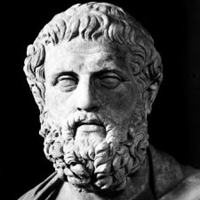Symbolism in Oedipus Rex
A symbol is anything which stands for another meaning or things. It implicitly signifies another situation or things. In Oedipus Rex, Sophocles used many symbols to indicate the hidden truth regarding the relationship of Oedipus and his search for truth.

Sophocles
The plague, the defilement, self-blinding, the riddle of the branches and chaplets of olive leaves, Oedipus-Jocasta relation, pinning the legs with skewer, and such many parts of the tragedy carry some symbolic meanings. The plague is the symbol of the crisis that Thebes is facing due to the sin unknowingly committed by Oedipus. It involves all the great and minor people into the search of a solution of the crisis. The defilement and pinning the legs of the baby with skewer symbolizes the meaning of the scapegoat. The baby is intended to sacrifice for the relief to king Laius and queen Jocasta. Oedipus, as the defilement in the city, is to sacrifice by death or exile for the relief to the citizens of Thebes. The branches and chaplets of olive leaves stand as a symbol of delegation. People gather with supplication for the rescue from the dreadful plague. The riddle of the Sphinx is the severe ordeal for Oedipus to succeed to the height of kingship, and meanwhile, it is also an accent to the marriage with mother and later to the catastrophe. Self-blinding is philosophical symbol. It is self-punishment for Oedipus's severe crime against his father, mother and the citizens. One who cannot see his deeds and their results even having eyes must make himself blind. The world is made for those who can really see like Teiresias and Creon. The struggle against the antagonistic forces is the symbol of struggle for mortal existence.
Most wide symbolic interpretations have been made of the Oedipus - Jocasta relationship. Sigmund Freud and his followers have called this relation with the term Oedipus-complex. Freud interprets it with "sexual impulses towards our mothers, and our first impulses of hatred and violence towards our fathers". Sigmund Freud interpreted the relation as a symbol of man’s unconscious act of trying to go back to his mother. The natural drive and attraction of a human male towards the body of his mother is called Oedipus-complex. The infant lives in complete satisfaction of his desires and a heavenly state when he is in his mother’s lap and also in the mother’s womb. So, he carries along the experience of that heavenly satisfaction in his unconscious mind, and he always wants to go back to the blissful state. When he grows up and into the world of struggle, uneasiness, pain and displeasure, he naturally desires to escape from the world of reality and go back to the same blissful state in the mother’s lap.
Oedipus Rex Study Center
Greek Tragic Vision Reflected in Oedipus Rex
Tension between Individual and State in Oedipus Rex
The Reversal of Events in Oedipus Rex
Plot Construction in Oedipus Rex
Dramatic Technique in Oedipus Rex
Oedipus Rex as a Classical Tragedy
Exploration into Man's Nature in Oedipus Rex
Rationalist and Fatalist view in Oedipus Rex
 |
bachelorandmaster.com |